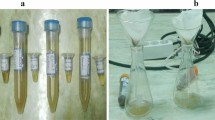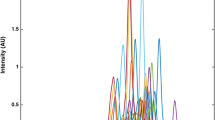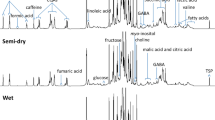Abstract
Characterization of coffee terroirs is important to determine authenticity and provide confidence for consumers to select the right product. In this regard, Amhara Region, which is located at the northwestern part of Ethiopia, produces various local coffee types with distinct cup qualities. The coffees are, however, not yet registered with certification marks or trademarks for indications of their geographical origins. This study was aimed at developing analytical methodology useful to determine the geographical origin of green coffee beans produced in Amhara Region based on multi-element analysis combined with multivariate statistical techniques. For this, a total of 120 samples of green coffee beans, collected from four major cultivating zones (West Gojjam, East Gojjam, Awi, and Bahir Dar Especial Zones) were analyzed for K, Mg, Ca, Mn, Fe, Cu, Fe, Co, Ni, Zn, Si, Cr, Cd, and Pb using inductively coupled plasma–optical emission spectroscopy. The elemental analysis data were subjected to principal component analysis (PCA) and linear discriminant analysis (LDA). PCA was used to explore the natural groupings of samples and the discriminatory ability of elements. Accordingly, the elements K, Mg, Ca, and Na were found to be the main discriminators among samples. LDA provided a model to classify the coffee samples based on their production zones with an accuracy of 94.2% and prediction ability of 93.4%. Thus, the elemental composition of green coffee beans can be used as a chemical descriptor in the authentication of coffee produced in Amhara Region.




Similar content being viewed by others
References
Nedzarek A, Torz A, Karakiewicz B, Clark JS, Laszczynska M, Kaleta A, Adler G (2013) Concentrations of heavy metals (Mn, Co, Ni, Cr, Ag, Pb) in coffee. Acta Biochim Pol 60(4):623–627
Gebeyehu BT, Bikilla SL (2015) Determination of caffeine content and antioxidant activity of coffee. Am J Appl Chem 3(2):69–76?
Amamo AA (2014) Coffee production and marketing in Ethiopia. Eur J Bus Manag 6:109–121
Gomez-Ruiz JA, Leake DS, Ames JM (2007) In vitro antioxidant activity of coffee compounds and their metabolites. J Agric Food Chem 55:6962–6969
Kufa T, Ayano A, Yilma A, Kumela T, Tefera W (2011) The contribution of coffee research for coffee seed development in Ethiopia. E3 J Agric Res Dev 1:9–16
Farah A (2012) Coffee constituents. In Chu YF (ed) Coffee: Emerging health effects and disease prevention. Wiley-Blackwell, Oxford, UK, pp 21–58
Mehari B, Redi-Abshiro M, Chandravanshi BS, Combrinck S, McCrindle R (2016) Characterization of the cultivation region of Ethiopian coffee by elemental analysis. J Anal Lett 49(15):2474–2489
Mehari B, Redi-Abshiro M, Chandravanshi BS, Combrinck S, Atlabachew M, McCrindle R (2016) Profiling of phenolic compounds using UPLC–MS for determining the geographical origin of green coffee beans from Ethiopia. J Food Compos Anal 45:16–25
Bertrand B, Villarreal D, Laffargue A, Posada H, Lashermes P, Dusser S (2008) Comparison of the effectiveness of fatty acids, chlorogenic acids, and elements for the chemometric discrimination of coffee (Coffea arabica L.) varieties and growing origins. J Agric Food Chem 56(6):2273–2280
Villarreal D, Laffargue A, Posada H, Bertrand B, Lashermes P, Dussert S (2009) Genotypic and environmental effects on coffee (Coffea arabica L.) bean fatty acid profile: impact on variety and origin chemometric determination. J Agric Food Chem 7(23):11321–11327
Ozyigit II, Uras ME, Yalcin IE, Severoglu Z, Demir G, Borkoev B, Salieva K, Yucel S, Erturk U, Solak AO (2019) Heavy metal levels and mineral nutrient status of natural walnut (Juglans regia L.) populations in Kyrgyzstan: nutritional values of kernels. Biol Trace Elem Res 189(1):277–290
Liang J, Wang Q, Huang B (2004) Concentrations of hazardous heavy metals in environmental samples collected in Xiamen, China, as determined by vapor generation non-dispersive atomic fluorescence spectrometry. Anal Sci 20:85–88
Habte G, Hwang IM, Kim JS, Hong JH, Hong YS, Choi JY, Nho EY, Jamila N, Khan N, Kim KS (2016) Elemental profiling and geographical differentiation of Ethiopian coffee samples through inductively coupled plasma-optical emission spectroscopy (ICP-OES), ICP-mass spectrometry (ICP-MS) and direct mercury analyzer (DMA). Food Chem 212:512–520
Dos Santos EJ, de Oliveira E (2001) Determination of mineral nutrients and toxic elements in Brazilian soluble coffee by ICP-AES. J Food Compos Anal 14:523–531
Pohl P, Stelmach E, Welna M, Szymczycha-Madeja A (2013) Determination of the elemental composition of coffee using instrumental methods. Food Anal Methods 6:598–613
AmorimFilho VR, Polito WL, Gomes Neto JA (2007) Comparative studies of the sample decomposition of green and roasted coffee for determination of nutrients and data exploratory analysis. J Br Chem Soc 18(1):47–53
Anderson KA, Smith BW (2002) Chemical profiling to differentiate geographic growing origins of coffee. J Agric Food Chem 50:2068–2075
Krivan V, Barth P, Morales AF (1993) Multi-element analysis of green coffee and its possible use for the determination of origin. MicrochimActa 110:217–236
Gure A, Chandravanshia BS, Taddese WG (2017) Metals in green coffee beans from major coffee-growing regions of Ethiopia. J Chem Int 3(4):359–369
Atlabachew M, Combrinck S, Sandasi M, Chen W, Viljoen A (2015) Rapid differentiation of Khat (Catha edulis Vahl. Endl.) using single point and imaging vibrational spectroscopy. VibSpectrosc 81:96–105
Mehari B, Redi-Abshiro M, Chandravanshi BS, Combrinck S, McCrindle R, Atlabachew M (2019) GC-MS profiling of fatty acids in green coffee (Coffea arabica L.) beans and chemometric modeling for tracing geographical origins from Ethiopia. J Sci Food Agric 99:3811–3823
Acknowledgments
This work was supported by the Ministry of Science and Technology of Ethiopia (3rd round, 2017) for the project title: “Enhancing the Quality and Market Share of the Underutilized Coffee of Amhara Region Through Chemical Analysis, Postharvest Loss Reduction and Mapping for Authentication (Branding)”. The authors are also thankful to Bahir Dar University for the laboratory facilities and the Amhara Region’s Bureau of Agriculture for its logistic support. Furthermore, Mr. Lakachew Emiru from the Amhara Bureau of Agriculture is also acknowledged for his guidance during sample collection.
Author information
Authors and Affiliations
Corresponding author
Ethics declarations
Conflict of Interest
The authors declare that they have no conflict of interest.
Additional information
Publisher’s Note
Springer Nature remains neutral with regard to jurisdictional claims in published maps and institutional affiliations.
Electronic supplementary material
ESM 1
(PDF 357 kb)
Rights and permissions
About this article
Cite this article
Endaye, M., Atlabachew, M., Mehari, B. et al. Combining Multi-Element Analysis with Statistical Modeling for Tracing the Origin of Green Coffee Beans from Amhara Region, Ethiopia. Biol Trace Elem Res 195, 669–678 (2020). https://doi.org/10.1007/s12011-019-01866-5
Received:
Accepted:
Published:
Issue Date:
DOI: https://doi.org/10.1007/s12011-019-01866-5




